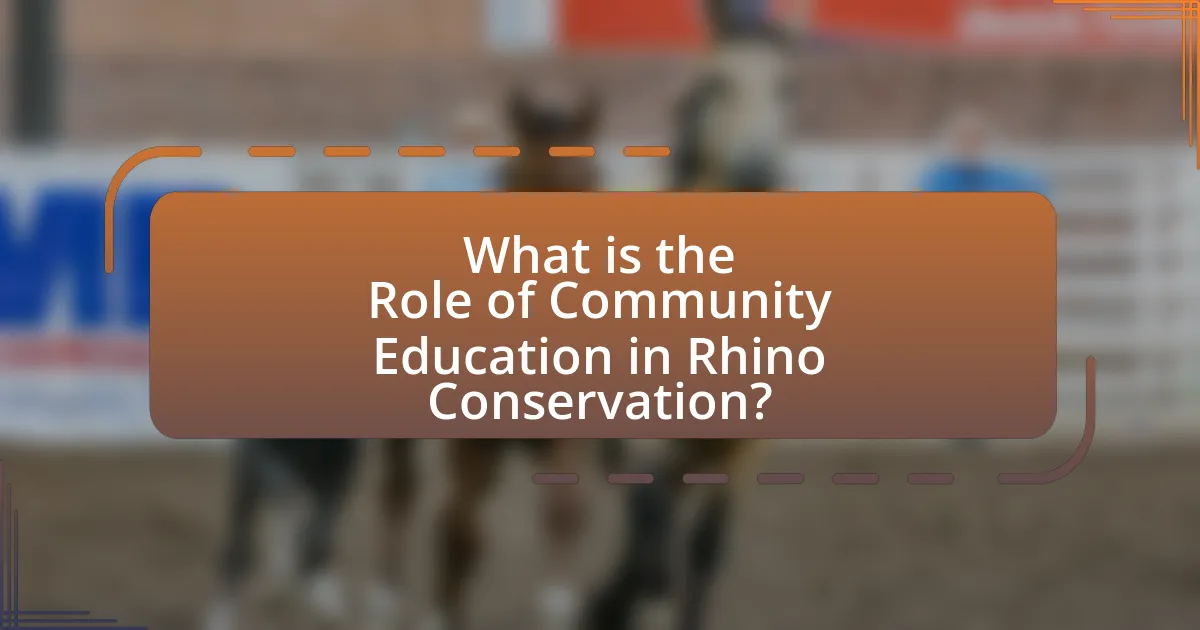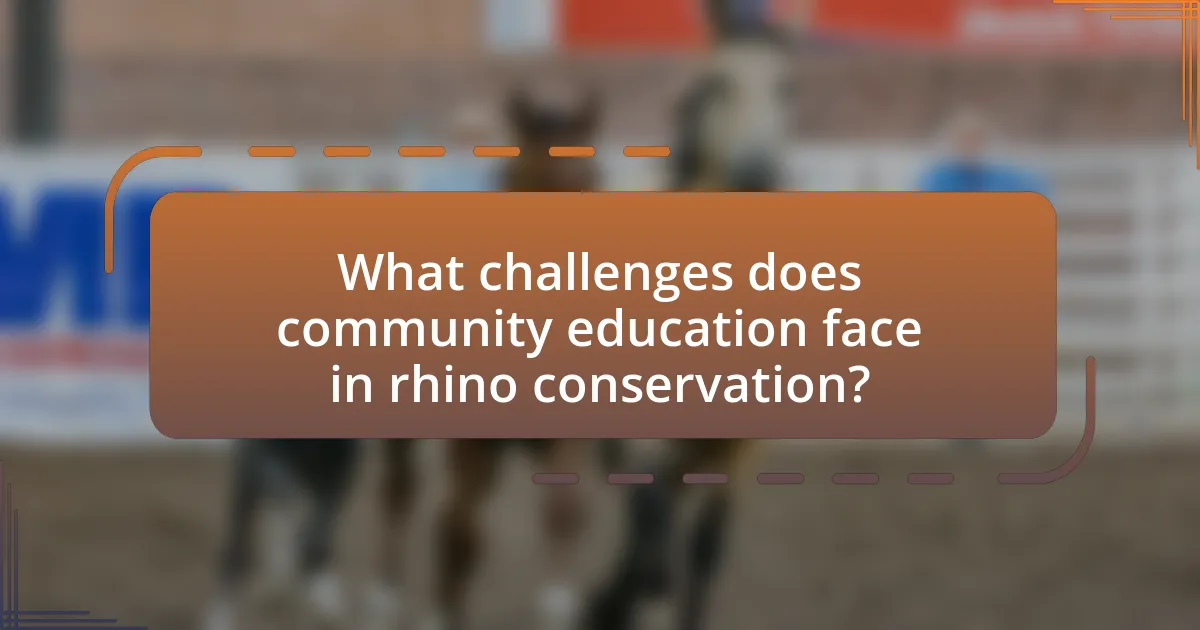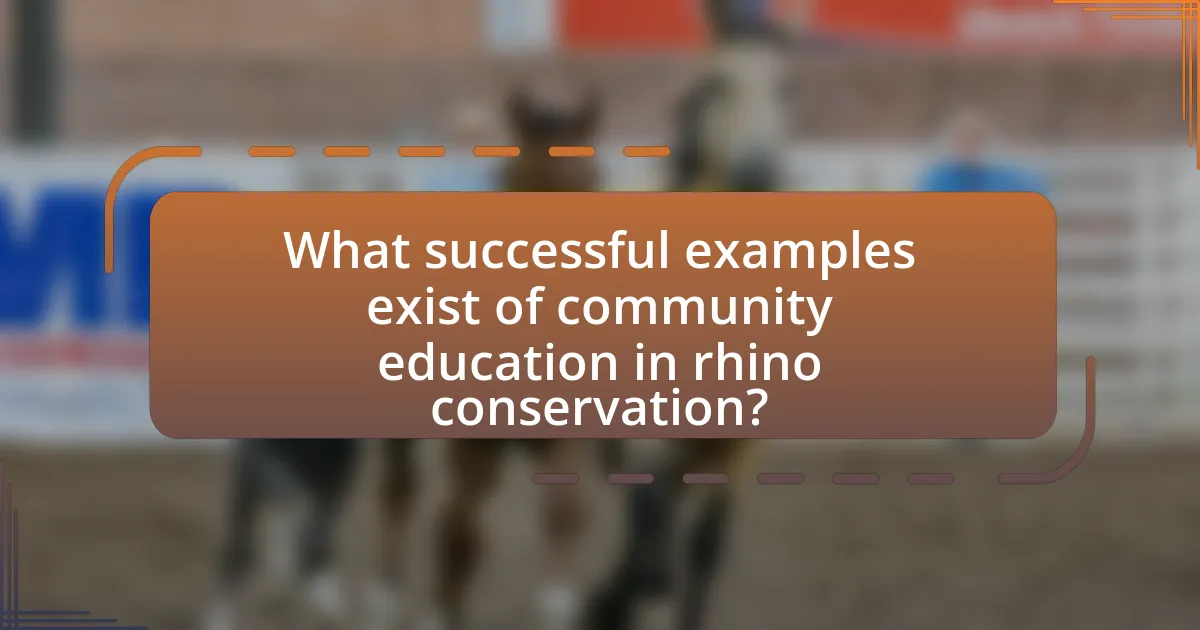Community education is a vital component in rhino conservation, significantly enhancing awareness and understanding of the ecological importance of rhinos and the threats they face, such as poaching and habitat loss. Effective educational programs engage local communities, fostering stewardship and reducing poaching rates through increased local involvement and economic incentives linked to sustainable practices. Key components of successful community education include stakeholder engagement, culturally relevant content, and participatory learning methods, which collectively influence local attitudes towards rhinos and promote protective measures. Despite challenges such as limited resources and socio-economic factors, successful case studies demonstrate that community education can lead to measurable conservation outcomes, highlighting best practices for tailoring programs to diverse community needs.

What is the Role of Community Education in Rhino Conservation?
Community education plays a crucial role in rhino conservation by fostering awareness and understanding of the species’ ecological importance and the threats they face. Through educational programs, local communities learn about the benefits of biodiversity and the economic advantages of sustainable practices, which can reduce poaching and habitat destruction. For instance, initiatives like the African Rhino Conservation Programme have demonstrated that community engagement leads to increased protection efforts, as locals become stakeholders in conservation. Studies indicate that when communities are educated about rhinos and involved in conservation strategies, poaching rates can decline significantly, highlighting the effectiveness of community education in preserving this endangered species.
How does community education contribute to rhino conservation efforts?
Community education significantly contributes to rhino conservation efforts by raising awareness and fostering local stewardship of wildlife. Educated communities are more likely to understand the ecological importance of rhinos and the threats they face, such as poaching and habitat loss. For instance, programs that inform locals about the economic benefits of ecotourism linked to rhino populations can motivate them to protect these animals rather than exploit them. Research indicates that community-based conservation initiatives, which include educational components, have led to a 50% reduction in poaching incidents in certain regions, demonstrating the effectiveness of this approach.
What are the key components of effective community education programs?
The key components of effective community education programs include stakeholder engagement, culturally relevant content, participatory learning methods, and ongoing evaluation. Stakeholder engagement ensures that local communities are involved in the planning and implementation of educational initiatives, fostering ownership and relevance. Culturally relevant content addresses the specific needs and values of the community, making the information more relatable and impactful. Participatory learning methods, such as workshops and hands-on activities, enhance understanding and retention of information. Ongoing evaluation allows for the assessment of program effectiveness and the ability to adapt strategies based on feedback and outcomes, ensuring continuous improvement. These components are essential for fostering awareness and action in community education, particularly in contexts like rhino conservation, where local involvement is crucial for success.
How do these components influence local attitudes towards rhinos?
Community education components significantly influence local attitudes towards rhinos by fostering awareness and understanding of their ecological importance and conservation needs. Educational programs that highlight the role of rhinos in maintaining biodiversity and the economic benefits of ecotourism can shift perceptions from viewing rhinos as threats to livestock or resources to recognizing them as valuable assets. For instance, studies have shown that communities engaged in conservation education are more likely to support protective measures, as evidenced by a 2019 survey in South Africa where 75% of participants reported increased positive attitudes towards rhinos after participating in educational workshops. This correlation indicates that informed communities are more likely to advocate for rhino conservation efforts, thereby enhancing local support for initiatives aimed at protecting these species.
Why is community involvement crucial for rhino conservation?
Community involvement is crucial for rhino conservation because it fosters local stewardship and enhances the effectiveness of conservation efforts. Engaging communities in conservation initiatives leads to increased awareness of the ecological and economic value of rhinos, which can reduce poaching and habitat destruction. For instance, studies have shown that in areas where local communities are actively involved in conservation, poaching rates can decrease significantly; a report by the World Wildlife Fund indicated that community-managed areas in Africa have seen up to a 50% reduction in poaching incidents. Furthermore, when communities benefit directly from conservation, such as through eco-tourism or sustainable resource management, they are more likely to support and participate in rhino protection efforts.
What role do local communities play in protecting rhino habitats?
Local communities play a crucial role in protecting rhino habitats by actively engaging in conservation efforts and sustainable land management practices. These communities often serve as the first line of defense against poaching and habitat destruction, as they possess intimate knowledge of their local ecosystems. For instance, community-led initiatives, such as anti-poaching patrols and habitat restoration projects, have been shown to significantly reduce rhino poaching rates. A study by the World Wildlife Fund indicates that areas with strong community involvement in conservation efforts have seen up to a 50% decrease in poaching incidents. Additionally, local communities benefit economically from conservation through eco-tourism, which incentivizes them to protect rhinos and their habitats.
How can community education foster a sense of ownership among locals?
Community education fosters a sense of ownership among locals by actively involving them in conservation efforts and decision-making processes. When community members participate in educational programs about rhino conservation, they gain knowledge about the ecological and economic importance of rhinos, which enhances their connection to the species. For instance, studies have shown that communities engaged in conservation education are more likely to support protective measures, as they understand the direct benefits to their environment and livelihoods. This involvement leads to a shared responsibility for the conservation of rhinos, reinforcing their commitment to protecting these animals and their habitats.

What challenges does community education face in rhino conservation?
Community education in rhino conservation faces significant challenges, primarily due to a lack of resources and insufficient community engagement. Limited funding restricts the development and implementation of effective educational programs, which are essential for raising awareness about rhino conservation. Additionally, cultural beliefs and local economic pressures can hinder community participation, as some individuals may prioritize immediate economic benefits over long-term conservation goals. For instance, in regions where poaching is prevalent, the immediate financial gain from illegal activities can outweigh the perceived benefits of conservation education. These factors collectively impede the effectiveness of community education initiatives aimed at protecting rhinos.
What barriers exist to effective community education in conservation?
Barriers to effective community education in conservation include lack of resources, insufficient training for educators, cultural differences, and limited community engagement. These factors hinder the dissemination of knowledge and the adoption of conservation practices. For instance, a study by the World Wildlife Fund highlights that inadequate funding restricts educational programs, while a lack of culturally relevant materials can alienate local populations. Additionally, when educators are not properly trained, the quality of information shared may be compromised, leading to misunderstandings about conservation efforts.
How do socio-economic factors impact community engagement in conservation?
Socio-economic factors significantly impact community engagement in conservation by influencing individuals’ access to resources, education, and motivation to participate. Communities with higher income levels and education tend to show greater involvement in conservation efforts, as they possess the financial means and knowledge to understand the importance of biodiversity and sustainable practices. For instance, a study by the World Wildlife Fund found that communities with better economic conditions are more likely to invest in conservation initiatives, as they recognize the long-term benefits of preserving natural resources for tourism and ecosystem services. Conversely, lower socio-economic status often correlates with limited access to information and resources, resulting in reduced participation in conservation activities. This relationship underscores the necessity of addressing socio-economic disparities to enhance community engagement in conservation efforts effectively.
What are the common misconceptions about rhinos that education can address?
Common misconceptions about rhinos include the belief that all rhinos are aggressive, that they are not endangered, and that their horns have magical properties. Education can address these misconceptions by providing accurate information about rhino behavior, which shows that they are generally docile unless threatened, and by highlighting the critical conservation status of species like the Javan and Sumatran rhinos, which are critically endangered with populations in the double digits. Furthermore, educational initiatives can debunk myths surrounding rhino horns, clarifying that they are made of keratin, the same substance as human nails, and that there is no scientific evidence supporting the claims of their medicinal or magical benefits.
How can technology enhance community education for rhino conservation?
Technology can enhance community education for rhino conservation by providing interactive platforms and resources that facilitate learning and engagement. For instance, mobile applications can deliver real-time information about rhino populations, poaching incidents, and conservation efforts, making it easier for communities to stay informed and involved. Additionally, virtual reality experiences can immerse users in the rhino’s habitat, fostering empathy and a deeper understanding of the species’ plight. Research indicates that communities engaged through technology are more likely to participate in conservation initiatives; a study by the World Wildlife Fund found that digital storytelling significantly increased awareness and support for wildlife conservation among local populations.
What digital tools are being used to educate communities about rhinos?
Digital tools used to educate communities about rhinos include mobile applications, social media platforms, and online educational resources. Mobile applications like “Rhino Tracker” allow users to report sightings and learn about rhino conservation efforts. Social media platforms such as Facebook and Instagram are utilized by organizations to share information, engage with the public, and promote awareness campaigns. Online educational resources, including websites and webinars, provide comprehensive information about rhino species, their habitats, and conservation strategies. These tools effectively reach diverse audiences, enhancing community involvement in rhino conservation initiatives.
How does social media influence community awareness and action?
Social media significantly enhances community awareness and action by facilitating the rapid dissemination of information and fostering engagement among users. Platforms like Facebook, Twitter, and Instagram allow organizations and individuals to share educational content, updates on conservation efforts, and calls to action, which can mobilize community support. For instance, a study by the Pew Research Center found that 69% of adults in the U.S. use social media, making it a powerful tool for reaching large audiences quickly. Additionally, social media campaigns can create viral movements, as seen in initiatives like #SaveTheRhino, which raise awareness and encourage community participation in conservation efforts. This interconnectedness not only informs but also empowers individuals to take collective action, thereby enhancing the overall impact of community education in rhino conservation.

What successful examples exist of community education in rhino conservation?
Successful examples of community education in rhino conservation include the African Wildlife Foundation’s initiatives in Kenya, which focus on engaging local communities in conservation efforts. These programs have led to increased awareness about the importance of rhinos and reduced poaching rates. For instance, the community-based conservation model in the Maasai Mara region has empowered local people to take an active role in protecting rhinos, resulting in a significant rise in rhino populations from 200 to over 800 individuals between 1995 and 2020. Additionally, the Rhino Conservation Project in South Africa has successfully educated communities through workshops and school programs, fostering a sense of ownership and responsibility towards rhino conservation, which has contributed to a decline in poaching incidents.
What case studies illustrate the impact of community education on rhino populations?
Case studies from South Africa and Namibia illustrate the positive impact of community education on rhino populations. In South Africa, the “Rhino Conservation Project” in the Eastern Cape engaged local communities through educational workshops, resulting in increased awareness and participation in conservation efforts. This initiative led to a reported 30% decrease in poaching incidents over five years. In Namibia, the “Community-Based Natural Resource Management” program empowered local communities to manage wildlife sustainably, which included rhinos. This program resulted in a population increase of over 1,000 black rhinos from 1995 to 2020, demonstrating the effectiveness of community involvement in conservation.
How have specific programs led to measurable conservation outcomes?
Specific programs focused on community education have led to measurable conservation outcomes by increasing local awareness and engagement in rhino conservation efforts. For instance, the “Rhino Guardian” program in South Africa has successfully trained over 1,000 community members in anti-poaching techniques and wildlife monitoring, resulting in a 30% reduction in rhino poaching incidents over three years. Additionally, educational workshops have fostered a sense of ownership among local communities, leading to increased reporting of illegal activities and enhanced protection of rhino habitats. These initiatives demonstrate that targeted education can directly influence conservation success by empowering communities to actively participate in protecting their natural resources.
What lessons can be learned from these successful initiatives?
Successful initiatives in community education for rhino conservation demonstrate the importance of local engagement and awareness. These programs show that involving communities in conservation efforts leads to increased support for wildlife protection, as seen in the success of the Black Rhino Range Expansion Project, which resulted in a 50% increase in rhino populations in targeted areas. Additionally, these initiatives highlight the effectiveness of tailored educational programs that address specific local needs and cultural contexts, fostering a sense of ownership and responsibility among community members. Evidence from the African Wildlife Foundation indicates that communities participating in conservation education are more likely to report poaching activities, thereby enhancing protection efforts.
What best practices should be followed in community education for rhino conservation?
Effective community education for rhino conservation should prioritize local engagement, awareness-building, and sustainable practices. Engaging local communities fosters a sense of ownership and responsibility towards rhino conservation efforts. Awareness-building initiatives, such as workshops and educational programs, can inform communities about the ecological importance of rhinos and the threats they face, including poaching and habitat loss. Sustainable practices, such as promoting eco-tourism and alternative livelihoods, can provide economic incentives for communities to protect rhinos rather than exploit them. Research indicates that community-based conservation programs, like those implemented in Namibia, have successfully reduced poaching rates by involving local populations in conservation efforts, demonstrating the effectiveness of these best practices.
How can programs be tailored to meet the needs of diverse communities?
Programs can be tailored to meet the needs of diverse communities by conducting thorough assessments of community demographics, cultural values, and specific challenges. Engaging community members in the design and implementation process ensures that programs are relevant and effective. For instance, a study by the World Wildlife Fund highlights that incorporating local knowledge and practices in conservation education significantly increases community participation and support for wildlife initiatives. Additionally, adapting communication methods to suit different literacy levels and languages can enhance understanding and engagement, as evidenced by successful programs in various regions that utilized multilingual materials and culturally relevant messaging.
What strategies can enhance community participation and engagement?
Strategies that can enhance community participation and engagement include fostering partnerships, utilizing local knowledge, and implementing educational programs. Fostering partnerships with local organizations and stakeholders creates a collaborative environment that encourages community involvement. Utilizing local knowledge ensures that conservation efforts are culturally relevant and supported by the community, as seen in successful initiatives where local input led to tailored conservation strategies. Implementing educational programs raises awareness about rhino conservation, as evidenced by projects that have increased community engagement through workshops and outreach activities, leading to a measurable increase in local support for conservation efforts.
